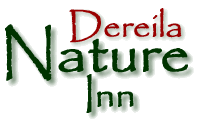 ___ ___
Welcome to our monthly celebration of nature and photography!
THIS MONTH:
» Quiz - More birds with red
» Five Things About...conifers
» Bird Food Recipe: Yummy Suet 2
PLUS - nature word |
joke of the month | celebrate nature dates for December
|
|
|
 |
As we move into December, the chills and beauty of the
Rocky Mountains welcome all to this month's newsletter.
|
|
 |
_ |
Where's Lily?
While you're reading this month, be sure to keep an eye out for Lily the Ladybug.
She's managed to hide in one of the photos, but which one?! |
|
|

Which insect has five eyes?
Compare your answer with the answer at the end of the newsletter.
|

 |
We've zoomed and cropped to create
this
month's
mystery picture, but what is it?
As usual, you'll find the answer at the end of the newsletter.
You'll find lots more of these puzzles in our Close-ups in Nature Section.
|
|
|
|
Last month's quiz featured birds with red, reddish or orange markings.
This month's quiz stays with the same theme with eight more birds to identify.
Make a list 1 through 8 and start matching the photographs with the names! Good luck.
(Don't worry if you have some names left over as there are more names than photos.) |
| |
 |
_ |
 |
_ |
 |
_ |
 |
Bird 1 |
|
Bird 2 |
|
Bird3 |
|
Bird 4 |
| |
|
|
|
|
|
|
|
|
|
|
|
|
|
Bird 5 |
|
Bird 6 |
|
Bird 7 |
|
Bird 8 |
| |
|
|
|
|
|
|
Barn Swallow |
|
Cedar Waxwing |
|
Downy Woodpecker |
|
Hairy Woodpecker |
| |
|
|
|
|
|
|
House Finch |
_ |
Pileated Woodpecker |
_ |
Red-breasted Nuthatch |
_ |
Red-breasted Sapsucker |
|
|
|
|
|
|
|
|
|
Spotted Towhee |
|
White-winged Crossbill |
|
|
|
|
| |
Quiz answers are found later in this issue of Whispers. |
| |
|

Demonstrate your wisdom and nature know-how by throwing
a few fascinating nature words into your daily conversations! |
| |
| I was chatting with a colleague the other day and mentioned that I really liked the inflorescence of the plant on her desk. A look of confusion appeared on her face. What on earth was I referring to? |
| |
a. The arrangement of the leaves. |
| |
b. The bright colour of the flower. |
| |
c. The interesting pattern of veins on the leaves. |
| |
d. A cluster of flowers on a stem. |
| |
| |
You'll find the answer at the end of this month's Whispers.
|
|

 |
The beaches and coastline offer a never-ending opportunity to glimpse aspects of nature that are often hidden away, deep beneath the waves.
This month's highlighted page is called From the Garden of the Sea. It's a photo essay which explores some of the fascinating seaweeds that are washed ashore by the changing tides.
|
|
|
|
__ |
|
One of our regular travellers, Penny Hershaw of Toronto, spotted this Brown Pelican which appears to be trying to groom itself, a rather tricky thing to do with such a huge bill! On the right, Penny's photo is of three Elegant Terns, with their shaggy crests. |
| |
|
|
|
|
|
Marilyn Flanagan of Florida, spotted these Moorhens having a wade in the water. |
|
Marilyn also got this great shot of a gorgeous
Tri-colored Heron. |
| |
|
|
|
|
|
This super close-up of a Cloudless Giant Sulphur Butterfly was taken by Jane and Walt of Red Gate Farm in Texas. |
|
Albertina Pianarosa of Ottawa, ON, sent in this photograph of some lovely, delicate Impatiens Balsamina flowers. |
A huge thank-you to Penny, Marilyn, Jane, Walt and Albertina for sending us these photos to enjoy.
We really appreciate you taking the time and making your contributions.
If you have a nature image you'd like to see in this section, please let us know!.
|
|

|
While wandering down by the sea, a male Eurasian Wigeon (the back bird) and a male American Wigeon swim by together on a calm day. |
| |
|

Do you have an idea for a fun caption for this photo of two Bald Eagles?
|
|
Here are some ideas:
#1 - "So, what are we gonna do then?"
#2 - "When do the ladies come by?"
If this month's photo inspires you, please send us your caption in an e-mail.
|
|

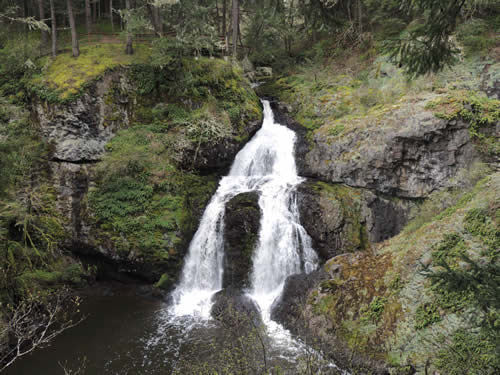 |
Near Victoria, BC, is a wonderful place call Witty's Lagoon, a lush park with trails through the rainforest that lead down to the sea. Explorers will come across the beautiful Sitting Lady Falls which plunge majestically down over rocks and boulders. |
| | |
|

___A couple of caterpillars were enjoying their time together munching away on a plant when, high above them, a butterfly suddenly fluttered by.
___"Boy," said one to his buddy, "you won't ever catch me up there."
___The other replied, "I agree! There's no way you'll never see me up there either!"
|
|
"It's so much safer lazing around down here."
|
| |
|

Here are this month's choices:
Bird - Snow Goose | Wildflower - Poet's Daffodil | Bug - Two-striped Grasshopper
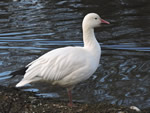 __ __ 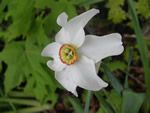 __ __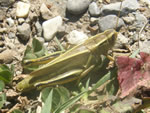
Click on the images to visit the pages.
| In the News - Canada Chooses National Bird |
There has been a great debate going on in Canada this past year: Which bird merits being Canada's official national bird? Online polls, magazine articles and even moderated debates were held and the winner is:
|
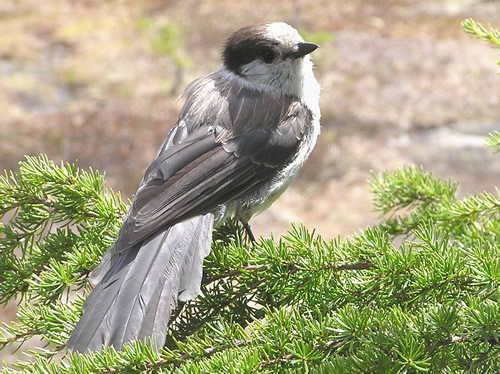 |
The Gray Jay, Perisoreus canadensis |
The Gray Jay, which is sometimes called the Canada Jay, lives year-round in Canada's coniferous forests and is found in every province and territory.
We have an article on this favourite bird right here.
Other birds considered for this honour were the Common Loon, the Snowy Owl and the Black-capped Chickadee. However, these were all rejected as they are already official provincial birds: Common Loon - Ontario; Snowy Owl - Quebec; Black-capped Chickadee - New Brunswick.
|
|
| A Little Reminder |
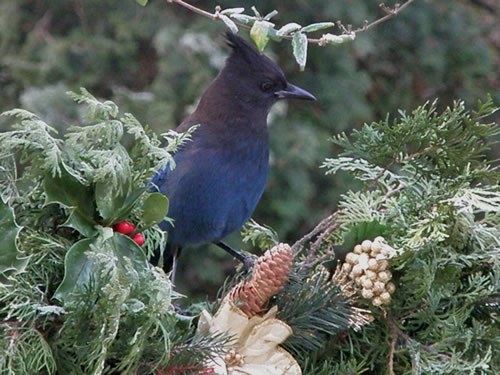 |
With the Christmas season fast approaching, remember to put outside a few decorations such as a wreath or other greenery. With a few hidden berries, you might be able to get some birds visiting and hopefully a lovely festive photograph. |
| | |
|
Tips and Ideas - Making a Perch |
|
These sponge-type paint brushes don't usually last very long, so when they are finished, pull off the dowel handle. It can be recycled into a perch for your bird feeding station! |
| |
|
You will also need to pick up a package of craft sticks that you can find at dollar stores. These are probably 1/4 inch thick. |
| |
 |
Cut one of the 1/4 inch craft sticks about 5 inches in length. On the old brush handle, use a nail to mark where the craft stick should go. Drill a hole through the brush handle, using a bit the same size as the craft stick, which you can now push through as shown here. |
| |
|
It's easy to drill a hole in a long for the old handle to go into. Another larger hole is for the bird food. The perch makes if easy for birds, such as this Dark-eyed Junco, to face their food source rather than hanging to perch sideways. |
| | |
|
| Bird Food Recipe - Yummy Suet 2 |
This suet can be served nicely to your feathered guests when it's stuffed into a pine cone.
|
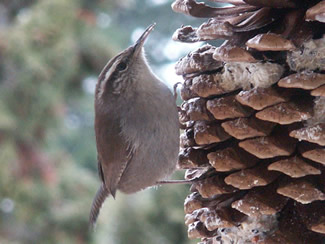 |
__ |
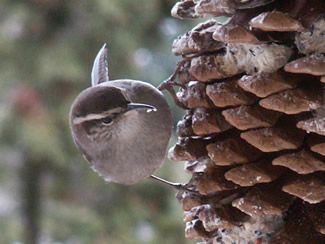 |
A Bewick's Wren enjoys a snack on a suet-stuffed pine cone. |
|
Ingredients: |
|
1/2 to 1 cup of peanut butter
1 cup chopped suet
1 cup of cornmeal
1 cup of wild birdseed
pines cones which have been dried out and are open
extra cornmeal
Plus one large pine cone
|
|
| |
Method: |
|
1. Tie a piece of twine around the pine cone about an inch below the cone's stem.
2. Soften the suet and peanut butter in the microwave on low heat for a minute or two.
3. Stir in the cornmeal and seed.
4. Hold the cone at the stem and use a knife to pack the mixture into the pine cone cracks and spaces.
5. If the mixture becomes too hard, soften again in the microwave.
6. Roll the cone in additional cornmeal and seed, lightly packing it into the cracks.
7. Hang the cone in a protected spot.
8. Put excess suet in the fridge. Soften and re-stuff the cone as required. |
|
| |
|
|
| Picture of the Week |
 |
|
Be sure to drop by the Inn every week to see the latest Picture of the Week.
You can also do so by clicking on the image to the left or by clicking here. |
|
| |
|
E-mail List
If you would like us to send you a quick e-mail when the next issue of Whispers is available, simply send us a quick note quick note and we will add you to our distribution list.
|
Past Issues
If you want to see any of the past issues of Whispers, they are available here.
|
|
|
|
__ |
 |
|
|
Wrapping up the Christmas Bird Count, National Bird Day is held every year on January 5. You can find out lots more about this celebration here. |
|
|
|
|

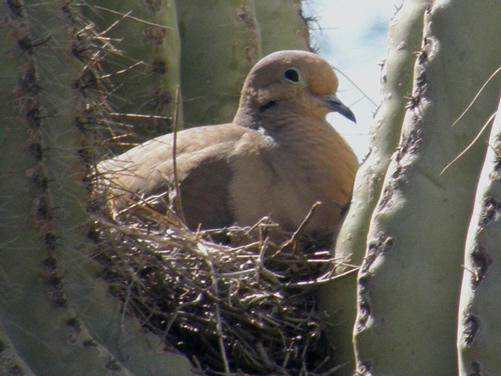 |
Did you know that the Mourning Dove, one of the most common birds in North America, can nest several times a year in warm climates? Both parents build a flimsy platform nest of twigs located from 5 to 25 feet up in a tree, bush or a cactus. |
| |
|

 |
There are numerous cities in North America that have chosen an official bird emblem. Aransas Pass in Texas chose the Brown Pelican. |
| |
|
|

|
Bumblebees have five eyes! There are two large eyes on the front of their heads and three smaller eyes on top. |
| |
|

 |
This month's mystery is solved! It's an acorn. How did you do?
|
| |
|

|
A plant's inflorescence is
d. a cluster of flowers that grow on a stem and resembles one large flower.
This is the inflorescence of the Sitka Valerian, Caleriana sitchensis. It ressembles an upside down umbrella and is said to have an umbel shape. The flower's inflorescence come in a variety of shapes including: spike-like; branched and elongated.
Click here to read our article called Flowers Shapes and Clusters.
 |
| |
|

 |
_ |
 |
_ |
 |
_ |
 |
Bird 1
Spotted Towhee |
|
Bird 2
White-winged Crossbill
|
|
Bird 3
Cedar Waxwing
|
|
Bird 4
Red-breasted Sapsucker |
| |
|
|
|
|
|
|
|
|
|
|
|
|
|
Bird 5
Red-breasted Nuthatch |
|
Bird 6
Downy Woodpecker |
|
Bird 7
Hairy Woodpecker |
|
Bird 8
Barn Swallow
|
| |
|
|
|
|
|
|
|
And if you're wondering what the two leftover names look like, here they are. |
|
|
|
|
|
|
|
|
|
House Finch |
|
Pileated Woodpecker |
|
|
| |
|
|
 |
Still looking for Lily?
If you need a little clue, click here! |
| |
|
|
Did you find Lily last month? |
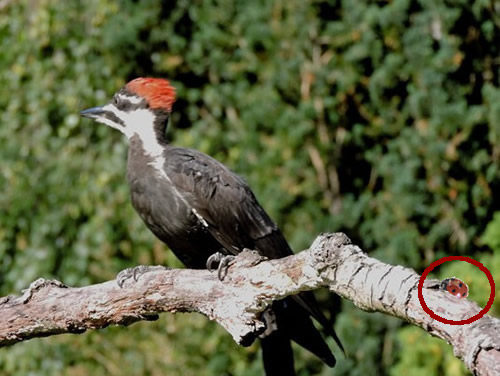 |
| |
|
We live in a very troubled and dark world but thank goodness we can still find serenity and peace in the wonderful world of nature. As 2016 comes to an end, we'd like to thank you all so very much for your amazing support during the year. May 2017 be full of happiness and joy for you and your friends and family. Merry Christmas to all!
We invite your comments and ideas - just drop us an e-mail. See you next month!
|
|